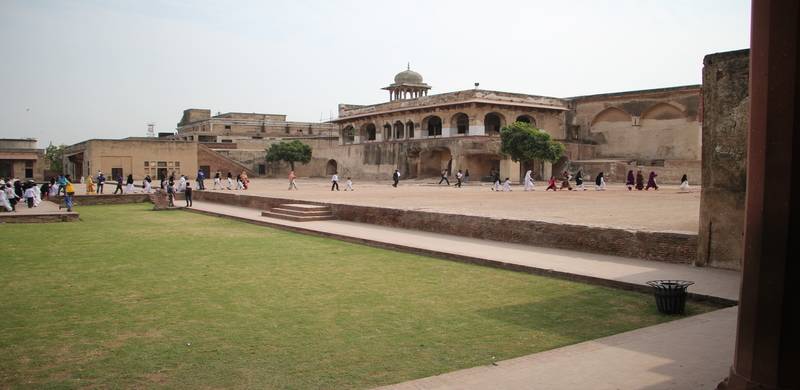
In the previous parts, I wrote about the history and some mesmerising monuments of Lahore Fort. There are numerous other monuments in this complex and today; let me take you to Akbar and Jahangir-era relics at the fort.
In the last part, I mentioned the Deewan-e-Aam. The backside of Diwan-e-Aam is known as Daulat Khana-e-Khas-o-Aam (Hall of Public and Private Audience) of Akbar, and includes among others, Jharoka or the ‘state balcony’. The interior of these double story apartments is decorated with exquisite stucco tracery in geometric and floral design. The decorative motifs were originally gilded. Traces of gold are still visible at various places. There are beautiful cusped marble arches in different chambers. The dado (lower part of the wall) of the main chamber is covered with white marble slabs, having borderlines of black and yellow stones in zigzag patterns. These rooms were the private chambers of the Mughal emperor Akbar.
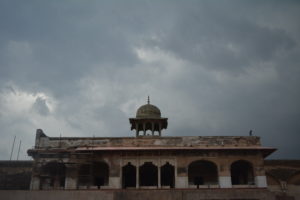
While standing in the grand arches of the Daulat Khana-e-Khas-o-Aam, one gets a beautiful unique view of the entire Jahangir’s Quadrangle. Like many other parts of the fort, this place had also been under several uses and had experienced changes during the Sikh and British Raj. The fresco and gold paintings were damaged during those eras.
From this place, you can take a panoramic view of Jahangir’s Quadrangle, which too, is the most visited part of Lahore fort and one can always see families sitting in its lawns. The construction of the Quadrangle was commenced by Akbar and completed by his son Jahangir in 1617-18. Having been built with the cost of seven hundred thousands of rupees, its features reflect Hindu temple architecture, reflective of Akbar’s policy of tolerance.
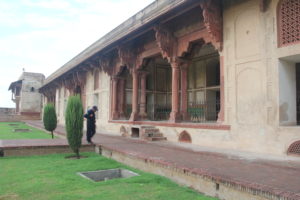
On the east and west row of Jahangir’s Quadrangle, dalans (porticos) encircle it and the red sandstone facade of dalans reflects Hindu art enriched with carved columns and elaborated brackets showing animal figurines. In the center of the north side, there is Jahangir’s sleeping room, currently being used as the Mughal Museum/Gallery and its front represents a modern reconstruction of the British period. There is also a garden situated in the quadrangle, having a square marble Mahtabi (platform) in the middle for the use of musicians and dancing girls. There is a large garden, inside the quadrangle, with a spacious tank in the centre.
The middle of the tank is occupied by a square marble platform called mahatabi, which contains a cistern with a marble fountain. There are numerous fountains in the tank. The main building of the court stands at the middle of the north side. It was Jahangir’s own sleeping chamber, and is known as 'Bari Khawabgah'.
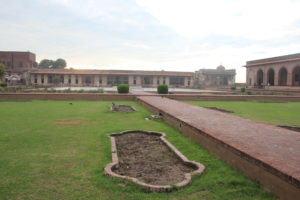
During the Sikh period, the Bari Khawabgah area was used as Ranjit Singh’s harem. The haveli of Kharak Singh was added in this quadrangle.
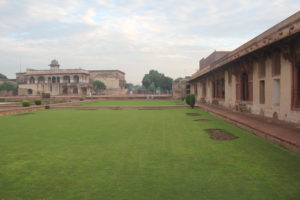
During the British period, the garden in the quadrangle was turned into a badminton court after filling up the tank and fountains. The sleeping chamber of Jahangir was used as an arms store. A hospital and a dispensary were established by the army in the quadrangle. Each of the adjoining Dalans was converted into a single residential unit for the military officers. The garden was totally destroyed and became non-existent. The area in front of the Dalans, originally designed and built as a lawn, was also converted into badminton courts. Both Seh Daris were also damaged and later one was completely destroyed. One of the Seh Dari is being conserved by the Walled City of Lahore Authority now. The authority has also made functional the fountains in the quadrangle.
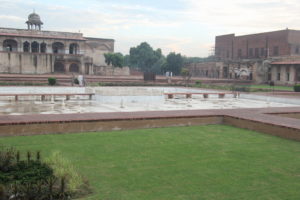
After 1903, steps were taken to restore it. Some of the front dalans of Bari Khawabgah were re-roofed and due to some cracks in the arches, a verandah was built in the front. Since the place was proposed for conversion into an armoury, some wooden doors were also fitted. The subterranean rooms adjoining this Bari Khawabgah were also cleared of dirt and mud to the original floor level in 1914-15 by the Archaeology Department during the British Period.
During the same time, the old foundation of the water tanks, mahatabi and paths along the fountains were also excavated and restored. The fountains, the tank and mahatabi, which we now see existing in the centre of this Quadrangle, are entirely new and were made possible through the restoration by the British Archaeology Department.
After the partition, some Lahoris led by Makki Brothers used to organize a ‘sound and light show’ on Independence Day. At one point, there used to be deer and peacocks in the garden. This quadrangle was also used for VIP dinners and musicians played their instrumental music here.
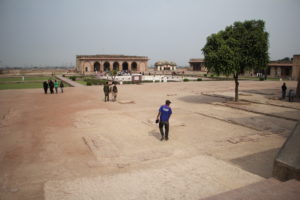
Both these places are a wonder inside the Lahore fort. Unfortunately, some parts of the buildings inside Jahangir’s Quadrangle were neglected. The Walled City of Lahore Authority has restored the guest houses of Jahangir’s Quadrangle.
In the last part, I mentioned the Deewan-e-Aam. The backside of Diwan-e-Aam is known as Daulat Khana-e-Khas-o-Aam (Hall of Public and Private Audience) of Akbar, and includes among others, Jharoka or the ‘state balcony’. The interior of these double story apartments is decorated with exquisite stucco tracery in geometric and floral design. The decorative motifs were originally gilded. Traces of gold are still visible at various places. There are beautiful cusped marble arches in different chambers. The dado (lower part of the wall) of the main chamber is covered with white marble slabs, having borderlines of black and yellow stones in zigzag patterns. These rooms were the private chambers of the Mughal emperor Akbar.

While standing in the grand arches of the Daulat Khana-e-Khas-o-Aam, one gets a beautiful unique view of the entire Jahangir’s Quadrangle. Like many other parts of the fort, this place had also been under several uses and had experienced changes during the Sikh and British Raj. The fresco and gold paintings were damaged during those eras.
From this place, you can take a panoramic view of Jahangir’s Quadrangle, which too, is the most visited part of Lahore fort and one can always see families sitting in its lawns. The construction of the Quadrangle was commenced by Akbar and completed by his son Jahangir in 1617-18. Having been built with the cost of seven hundred thousands of rupees, its features reflect Hindu temple architecture, reflective of Akbar’s policy of tolerance.

On the east and west row of Jahangir’s Quadrangle, dalans (porticos) encircle it and the red sandstone facade of dalans reflects Hindu art enriched with carved columns and elaborated brackets showing animal figurines. In the center of the north side, there is Jahangir’s sleeping room, currently being used as the Mughal Museum/Gallery and its front represents a modern reconstruction of the British period. There is also a garden situated in the quadrangle, having a square marble Mahtabi (platform) in the middle for the use of musicians and dancing girls. There is a large garden, inside the quadrangle, with a spacious tank in the centre.
The middle of the tank is occupied by a square marble platform called mahatabi, which contains a cistern with a marble fountain. There are numerous fountains in the tank. The main building of the court stands at the middle of the north side. It was Jahangir’s own sleeping chamber, and is known as 'Bari Khawabgah'.

During the Sikh period, the Bari Khawabgah area was used as Ranjit Singh’s harem. The haveli of Kharak Singh was added in this quadrangle.

During the British period, the garden in the quadrangle was turned into a badminton court after filling up the tank and fountains. The sleeping chamber of Jahangir was used as an arms store. A hospital and a dispensary were established by the army in the quadrangle. Each of the adjoining Dalans was converted into a single residential unit for the military officers. The garden was totally destroyed and became non-existent. The area in front of the Dalans, originally designed and built as a lawn, was also converted into badminton courts. Both Seh Daris were also damaged and later one was completely destroyed. One of the Seh Dari is being conserved by the Walled City of Lahore Authority now. The authority has also made functional the fountains in the quadrangle.

After 1903, steps were taken to restore it. Some of the front dalans of Bari Khawabgah were re-roofed and due to some cracks in the arches, a verandah was built in the front. Since the place was proposed for conversion into an armoury, some wooden doors were also fitted. The subterranean rooms adjoining this Bari Khawabgah were also cleared of dirt and mud to the original floor level in 1914-15 by the Archaeology Department during the British Period.
During the same time, the old foundation of the water tanks, mahatabi and paths along the fountains were also excavated and restored. The fountains, the tank and mahatabi, which we now see existing in the centre of this Quadrangle, are entirely new and were made possible through the restoration by the British Archaeology Department.
After the partition, some Lahoris led by Makki Brothers used to organize a ‘sound and light show’ on Independence Day. At one point, there used to be deer and peacocks in the garden. This quadrangle was also used for VIP dinners and musicians played their instrumental music here.

Both these places are a wonder inside the Lahore fort. Unfortunately, some parts of the buildings inside Jahangir’s Quadrangle were neglected. The Walled City of Lahore Authority has restored the guest houses of Jahangir’s Quadrangle.
